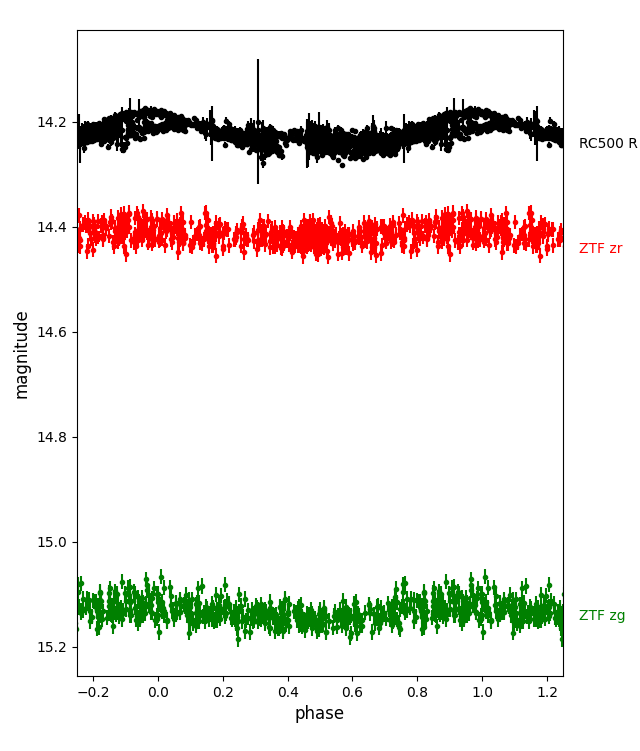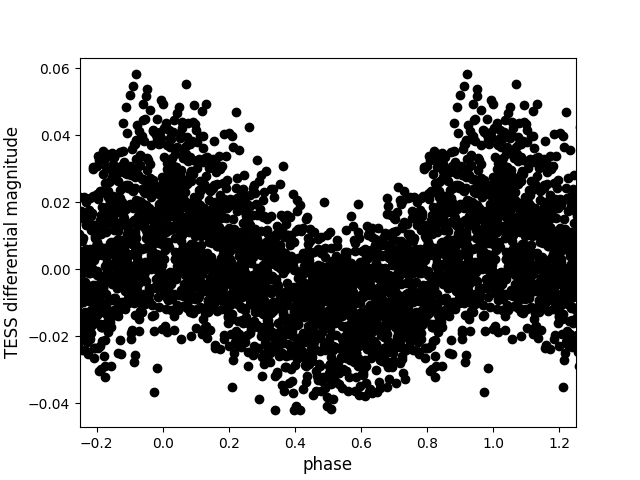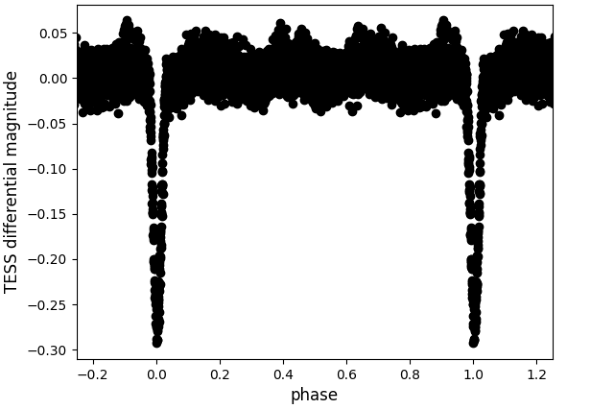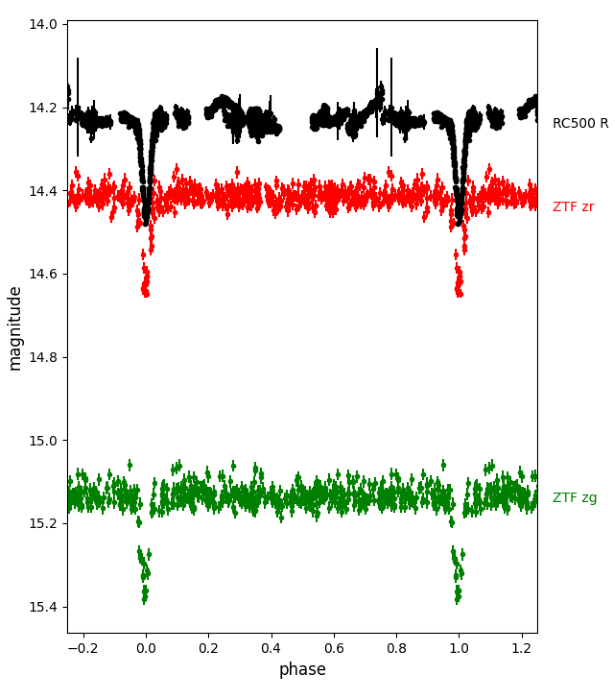|
Peremennye Zvezdy (Variable Stars) 44, No. 7, 2024 Received 23 September; accepted 10 October. |
Article in PDF |
|
DOI: 10.24412/2221-0474-2024-44-78-87
|
2MASS J23453766+7134365, New Eclipsing Binary with a Possible Pulsating Component
A. N. Tarasenkov, S. A. Naroenkov
Institute of Astronomy of Russian Academy of Sciences, 48 Pyatnitskaya Str., Moscow 119017, Russia; tarasenkov@inasan.ru
|
We present our study of 2MASS J23453766+7134365, an
eclipsing variable star with a possible pulsating component, from
a field in Cepheus. The star exhibits V-shaped eclipses with a
depth of approximately 0 |
1. Variability discovery of 2MASS J23453766+7134365
In 2022, a long time series of a field in Cepheus (approximate center 23
| Date | Filter | No. of observations |
| 2022-09-05 | 220 | |
| 2022-09-10 | 169 | |
| 2022-09-11 | 197 | |
| 2022-09-14 | 130 | |
| 2022-09-15 | 228 | |
| 2022-09-17 | 92 | |
| 2022-09-19 | 532 | |
| 2022-09-20 | 285 | |
| 2022-09-23 | 147 | |
| 2022-09-24 | 118 | |
| 2022-09-27 | 253 | |
| 2022-09-30 | 388 | |
| 2022-10-06 | 222 | |
| 2022-10-07 | 357 | |
| 2022-10-11 | 227 | |
| 2022-10-12 | 378 | |
| 2022-10-13 | 255 | |
| 2022-10-14 | 226 | |
| 2022-10-25 | 346 | |
| 2022-10-28 | 289 | |
| 2022-10-29 | 446 | |
| 2022-10-30 | 320 | |
| 2022-11-01 | 210 | |
| 2022-11-06 | 384 | |
| 2022-11-07 | 231 | |
| 2022-11-08 | 475 | |
| 2022-11-10 | 381 | |
| 2022-11-11 | 216 | |
| 2022-11-12 | 439 | |
| 2022-11-14 | 446 | |
| 2022-11-15 | 202 |
Astrosib RC-500 is a Ritchie-Chretien narrow-field photometric
telescope with the focal ratio ![]() and aperture 500 mm. It is
equipped with a Fli Proline 16803 CCD camera. The camera chip size
is
and aperture 500 mm. It is
equipped with a Fli Proline 16803 CCD camera. The camera chip size
is
![]() pixels, with the pixel size of 9 microns. When
using a
pixels, with the pixel size of 9 microns. When
using a ![]() mm CCD detector, the telescope's field of
view is
mm CCD detector, the telescope's field of
view is ![]() . The telescope is equipped with a Bessel
system
. The telescope is equipped with a Bessel
system ![]() filter wheel for multicolor photometry. It is
installed on an Astrosib FM700 mount with worm drives. The
telescope is installed as a part of the program of the Institute
of Astronomy of Russian Academy of Sciences aimed at creating
robotic observatories (Naroenkov & Nalivkin 2018, 2019) and
operates in an automatic mode.
filter wheel for multicolor photometry. It is
installed on an Astrosib FM700 mount with worm drives. The
telescope is installed as a part of the program of the Institute
of Astronomy of Russian Academy of Sciences aimed at creating
robotic observatories (Naroenkov & Nalivkin 2018, 2019) and
operates in an automatic mode.
The telescope's field of view and long exposures used during observations of the field mentioned above made it possible to conduct variable star search in this data. Time series of archive observations were processed with the VaST software package (Sokolovsky & Lebedev 2018) to detect variable objects. We found a photometrically variable source not mentioned as a known variable in the VSX database1or in the GCVS (Samus et al. 2017). It was identified as 2MASS J23453766+7134365 (further, 2M2345) in the 2MASS All-Sky Catalog of Point Sources (Cutri et al. 2003).
2. Data collection and reduction
Because the target star observed in the archival dataset is significantly brighter than 2M2345, the exposures of the archival frames were too short to derive the light curve and light elements of 2M2345 with a high precision. To overcome this problem, we collected ZTF photometry (Bellm et al. 2019; Masci et al. 2019) using the SNAD ZTF viewer (Malanchev et al. 2023), ASAS-SN photometry (Shappee et al. 2014), and TESS data (Ricker et al. 2014); they were processed using the Lightkurve library algorithms (Lightkurve Collaboration, 2018). Reductions of TESS data are described in detail in Tarasenkov (2024). The light elements were determined using the WinEfk tool developed by V. P. Goranskij2. The archival light curve, folded with the elements we obtained, is presented in Fig. 1. The coordinates and parallax were taken from Gaia DR3 (Gaia Collaboration 2023).
We also conducted follow-up observations with the RC600 telescope
of the Caucasian Mountain Observatory (Berdnikov et al. 2020) and
the Astrosib RC500 telescope of the INASAN Kislovodsk Observatory
(Naroenkov et al. 2024). In total, we obtained 413 measurements in
the ![]() band, 1382 measurements in the
band, 1382 measurements in the ![]() band, along with
magnitude estimates in
band, along with
magnitude estimates in ![]() ,
, ![]() , and
, and ![]() . The log of our follow-up
observations can be found in Table 2.
. The log of our follow-up
observations can be found in Table 2.
| Date | Filter | No. of observations | Telescope |
| 2023-11-07 | 120 | RC500-Terskol | |
| 2023-11-11 | 51 | RC500-Terskol | |
| 2023-11-11 | 37 | RC600-CMO | |
| 2023-12-07 | 60 | RC500-Kislovodsk | |
| 2024-01-03 | 18 | RC500-Kislovodsk | |
| 2024-01-24 | 188 | RC600-CMO | |
| 2024-01-30 | 70 | RC500-Kislovodsk | |
| 2024-02-24 | 17 | RC500-Kislovodsk | |
| 2024-02-24 | 17 | RC500-Kislovodsk | |
| 2024-02-24 | 188 | RC500-Kislovodsk | |
| 2024-02-24 | 17 | RC500-Kislovodsk | |
| 2024-02-24 | 17 | RC500-Kislovodsk | |
| 2024-03-03 | 90 | RC500-Kislovodsk | |
| 2024-04-02 | 214 | RC500-Kislovodsk | |
| 2024-04-28 | 130 | RC500-Kislovodsk | |
| 2024-05-19 | 189 | RC500-Kislovodsk | |
| 2024-05-22 | 90 | RC500-Kislovodsk | |
| 2024-06-11 | 125 | RC500-Kislovodsk | |
| 2024-06-16 | 24 | RC500-Kislovodsk | |
| 2024-06-21 | 62 | RC500-Kislovodsk | |
| 2024-06-23 | 122 | RC500-Kislovodsk |
To perform photometry, we used AstroimageJ software (Collins et
al. 2017). We analyzed nearby stars and selected non-variable
ones, with magnitudes and color indices close to those of 2M2345,
as photometric standards. The ![]() magnitudes of standard stars
were taken from APASS (Henden et al. 2012) and the Gaia DR3
Syntphot catalogue (Gaia Collaboration et al. 2023). A finding
chart with comparison stars is shown in Fig. 2.
magnitudes of standard stars
were taken from APASS (Henden et al. 2012) and the Gaia DR3
Syntphot catalogue (Gaia Collaboration et al. 2023). A finding
chart with comparison stars is shown in Fig. 2.
 |
Fig. 2. The RC500-Kislovodsk field. 2MASS J23453766+713436 is marked with a green circle and signed T1, photometric comparison stars are marked with red circles and signed C2-C12. |
3. Stellar characteristics and evidence for pulsations
The star exhibits V-shaped eclipses with a depth of approximately
0![]() 25 in the
25 in the ![]() band every 2
band every 2![]() 4405; secondary minima are not
detected. This indicates that eclipses are tangential, and the
brightness of the secondary component may be significantly lower
than that of the primary. The light elements for eclipses are:
4405; secondary minima are not
detected. This indicates that eclipses are tangential, and the
brightness of the secondary component may be significantly lower
than that of the primary. The light elements for eclipses are:
![]() . The light curves
of 2M2345, folded with these elements, are shown in Fig. 3 (TESS
data) and Fig. 4 (our observations and ZTF data).
. The light curves
of 2M2345, folded with these elements, are shown in Fig. 3 (TESS
data) and Fig. 4 (our observations and ZTF data).
 |
Fig. 5.
Astrosib RC500-Kislovodsk and ZTF light
curves, folded with light elements
|
 |
Fig. 6.
TESS Sector 52 light curve in
pulsation-active state, folded with the period 0 |
Also, sinusoidal brightness variations are detected with an
amplitude of about 0![]() 1 and a period of 0
1 and a period of 0![]() 6791. The
ephemeris for them is
6791. The
ephemeris for them is
![]() . These variations are visible both in ground-based observations
(Fig. 5, folded RC500-Kislovodsk and ZTF data) and in TESS space
mission photometry (Fig. 6, folded Sector 52 data). They appear
and disappear quasi-periodically with a characteristic time of
several (6-7) days. Such variations may be associated with
pulsations of one of the components of the binary system caused by
tidal interactions (Jayaraman et al. 2024). This effect is clearly
visible in TESS light curves (Figs. 7-8) and is stable on
timescales of years (Sector 17-18 data were obtained in 2019,
while Sectors 78-79 were observed in 2024).
. These variations are visible both in ground-based observations
(Fig. 5, folded RC500-Kislovodsk and ZTF data) and in TESS space
mission photometry (Fig. 6, folded Sector 52 data). They appear
and disappear quasi-periodically with a characteristic time of
several (6-7) days. Such variations may be associated with
pulsations of one of the components of the binary system caused by
tidal interactions (Jayaraman et al. 2024). This effect is clearly
visible in TESS light curves (Figs. 7-8) and is stable on
timescales of years (Sector 17-18 data were obtained in 2019,
while Sectors 78-79 were observed in 2024).
According to color-spectral type relations (Fitzgerald 1970; Ducati et al. 2001), the "integral" spectral type of the system is K2-K5.
Main properties of 2M2345 are presented in Table 3.
| Parameter | Value | Source |
| RA J2000 | 23 |
Gaia DR3 (Gaia Collaboration et al. 2023) |
| DEC J2000 | 71 |
Gaia DR3 (Gaia Collaboration et al. 2023) |
| Parallax, mas |
|
Gaia DR3 (Gaia Collaboration et al. 2023) |
| Orbital period | 2 |
This work |
| Pulsation period | 0 |
This work |
|
|
This work | |
|
|
This work | |
|
|
This work | |
|
|
This work | |
|
|
This work | |
|
|
2MASS (Cutri et al. 2003) | |
|
|
2MASS (Cutri et al. 2003) | |
|
|
2MASS (Cutri et al. 2003) | |
| Luminosity, |
7.72 | TIC v8.2 (Paegert et al. 2021) |
4. Results and conclusions
2MASS J23453766+7134365 was detected in the archive of Astrosib
RC500 telescope of the Terskol observatory and identified as an
eclipsing variable star with the period 2![]() 4405. The primary
eclipses are V-shaped with a depth of approximately 0
4405. The primary
eclipses are V-shaped with a depth of approximately 0![]() 25 in
25 in ![]() band; secondary minima are not detected. Also, sinusoidal
brightness variations are detected with an amplitude of less than
0
band; secondary minima are not detected. Also, sinusoidal
brightness variations are detected with an amplitude of less than
0![]() 1 and a period of 0
1 and a period of 0![]() 6791. They appear and disappear
quasi-periodically, with a characteristic time from 6 to 7 days.
This effect may be a consequence of pulsations of one of the
components.
6791. They appear and disappear
quasi-periodically, with a characteristic time from 6 to 7 days.
This effect may be a consequence of pulsations of one of the
components.
For further study of the star, we conducted follow-up observations
with the RC600 telescope (Caucasian Mountain Observatory) and the
Astrosib RC500 telescope of the INASAN Kislovodsk observatory; we
also collected photometric data from the ZTF, ASAS-SN, and TESS
surveys. High-quality light curves in many photometric bands were
obtained, and the light elements of the system were derived. The
light elements for eclipses are
![]() ; for sinusoidal variations, the light elements
are
; for sinusoidal variations, the light elements
are
![]() . The nature of
the object is not fully understood, and it requires further
research.
. The nature of
the object is not fully understood, and it requires further
research.
Acknowledgements
The authors are grateful to Drs. V. P. Goranskij and K. V. Sokolovsky for providing their software. This research has made use of the International Variable Star Index (VSX) database, operated at AAVSO, Cambridge, Massachusetts, USA. This research made use of Lightkurve, a Python package for Kepler and TESS data analysis (Lightkurve Collaboration 2018). The authors thank the team of the Caucasus Mountain Observatory of Moscow State University for providing observational time and Prof. N. N. Samus for fruitful discussions.
References:
Bellm, E. C., Kulkarni, S. R., Graham, M. J., et al. 2019, Publ. Astron. Soc. Pacific, 131, 018002
Berdnikov, L. N., Belinskii, A. A., Shatskii, N. I., et al. 2020, Astron. Rep., 64, 310
Collins, K. A., Kielkopf, J. F., Stassun, K. G., et al. 2017, Astron. J., 153, article id. 77
Cutri, R. M., Skrutskie, M. F., van Dyk, S., et al. 2003, The
IRSA 2MASS All-Sky Point Source Catalog, NASA/IPAC Infrared
Science Archive,
http://irsa.ipac.caltech.edu/applications/Gator/
Ducati, J. R., Bevilacqua, C. M., Rembold, S. B., et al. 2001, Astrophys. J., 558, 309
Fitzgerald, M. P. 1970, Astron. & Astrophys., 4, 234
Gaia Collaboration, Vallenari, A., Brown, A. G. A., et al. 2023, Astron. & Astrophys., 674, A1
Henden, A. A., Levine, S. E., Terrell, D., et al. 2012, Journ. of the AAVSO, 40, 430
Jayaraman, R., Rappaport, S., Powell, B., et al. 2024, arXiv:2409.03815
Lightkurve Collaboration, Cardoso, J. V. d. M., Hedges, C., et al. 2018, Astrophys. Source Code Lib., record ascl:1812.013.
Malanchev, K., Kornilov, M. V., Pruzhinskaya, M. V., et al. 2023, Publ. Astron. Soc. Pacific, 135, 024503
Masci, F. J., Laher, R. R., Rusholme, B., et al. 2019, Publ. Astron. Soc. Pacific, 131, 995
Naroenkov, S. A. & Nalivkin, M. A. 2018, INASAN Sci. Rep., 2, 339
Naroenkov, S. A. & Nalivkin, M. A. 2019, INASAN Sci. Rep., 3, 87
Naroenkov, S. A., Tarasenkov, A. N., & Nalivkin, M. A., 2024, INASAN Sci. Rep., 9, 6
Paegert, M., Stassun, K. G., Collins, K. A., et al. 2021, arXiv:2108.04778
Ricker, G. R., Winn, J. N., Vanderspek, R., et al. 2014, Proc. of the SPIE, 9143, 15
Samus, N. N., Kazarovets, E. V., Durlevich, O. V., et al. 2017, Astron. Rep., 61, 80
Shappee, B., Prieto, J., Stanek, K. Z., et al. 2014, American Astron. Soc., AAS Meeting 223, id.236.03
Sokolovsky, K. V. & Lebedev, A. A. 2018, Astron. & Computing, 22, 28
Tarasenkov, A. N. 2024, INASAN Sci. Rep., in preparation




